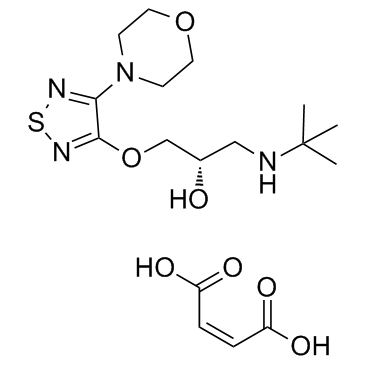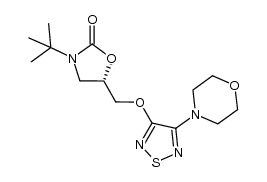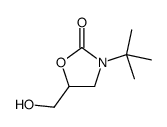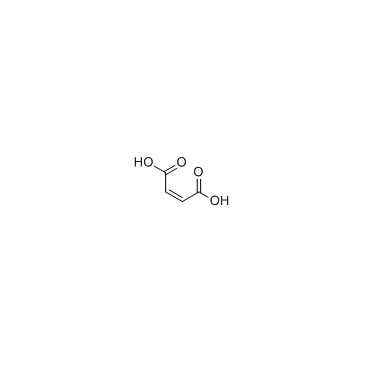26921-17-5
| 中文名 | 马来酸噻吗洛尔 |
|---|---|
| 英文名 | (S)-timolol maleate |
| 中文别名 |
(S)-3-[3-(叔丁基氨基)-2-羟基丙氧基]-4-吗啉基-1,2,5-噻二唑马来酸盐
马来酸噻吗心安 奥沙拉秦钠 (S)-马来酸噻吗洛尔 |
| 英文别名 |
(-)-1-(tert-Butylamino)-3-[(4-morpholino-1,2,5-thiadiazol-3-yl)oxy]-2-propanol Maleate (1:1) (Salt)
(S)-1-[(1,1-Dimethylethyl)amino]-3-[[4-(4-morpholinyl)-1,2,5-thiadiazol-3-yl]oxy]-2-propanol (Z)-2-Butenedioate (1:1) (Salt) Timolol maleate salt Betim acide (2Z)-but-2-ènedioïque - (2S)-1-[(1,1-diméthyléthyl)amino]-3-[(4-morpholin-4-yl-1,2,5-thiadiazol-3-yl)oxy]propan-2-ol (1:1) Tenopt (2Z)-But-2-endisäure--(2S)-1-(tert-butylamino)-3-[(4-morpholin-4-yl-1,2,5-thiadiazol-3-yl)oxy]propan-2-ol(1:1) Proflax Aquanil (2S)-1-[(2-Methyl-2-propanyl)amino]-3-{[4-(4-morpholinyl)-1,2,5-thiadiazol-3-yl]oxy}-2-propanol (2Z)-2-butenedioate (1:1) Timorom (2S)-1-(tert-Butylamino)-3-{[4-(morpholin-4-yl)-1,2,5-thiadiazol-3-yl]oxy}propan-2-ol (2Z)-but-2-enedioate (1:1) (S)-Timolol maleate Rysmon TG EINECS 248-111-5 Optimol (-)-Timolol Maleate Timacar (S)-(-)-Timolol Maleate (2S)-1-(tert-butylamino)-3-[(4-morpholin-4-yl-1,2,5-thiadiazol-3-yl)oxy]propan-2-ol (2Z)-but-2-enedioate (salt) (2S)-1-[(1,1-Dimethylethyl)amino]-3-[[4-(4-morpholinyl)-1,2,5-thiadiazol-3-yl]oxy]-2-propanol (2Z)-2-Butenedioate (1:1) (Salt) Temserin MFCD00058356 2-Propanol, 1-[(1,1-dimethylethyl)amino]-3-[[4-(4-morpholinyl)-1,2,5-thiadiazol-3-yl]oxy]-, (2S)-, (2Z)-2-butenedioate (1:1) (salt) Timolol maleate (S)-Timolol (Maleate) |
| 描述 | (S)-Timolol马来酸盐是非选择性β-肾上腺素受体拮抗剂,对β1和β2受体亚型的Ki分别为1.97和2.0 nM。 |
|---|---|
| 相关类别 | |
| 参考文献 |
| 沸点 | 704.6ºC at 760 mmHg |
|---|---|
| 熔点 | 202-203 °C(lit.) |
| 分子式 | C17H28N4O7S |
| 分子量 | 432.492 |
| 闪点 | 380ºC |
| 精确质量 | 432.167877 |
| PSA | 182.58000 |
| LogP | 0.67020 |
| 外观性状 | powder | white to off-white |
| 蒸汽压 | 7.7E-21mmHg at 25°C |
| 储存条件 | 放入紧密的贮藏器内,储存在阴凉,干燥的地方 |
| 稳定性 | 常温常压下稳定 避免接触强 氧化剂 |
| 水溶解性 | H2O: soluble |
| 计算化学 | 1、 氢键供体数量:4 2、 氢键受体数量:11 3、 可旋转化学键数量:9 4、 拓扑分子极性表面积(TPSA):154 5、 重原子数量:29 6、 表面电荷:0 7、 复杂度:429 8、 同位素原子数量:0 9、 确定原子立构中心数量:1 10、 不确定原子立构中心数量:0 11、 确定化学键立构中心数量:1 12、 不确定化学键立构中心数量:0 13、 共价键单元数量:2 |
| 更多 | 1. 性状: 未确定 2. 密度(g/mL,25/4℃):未确定 3. 相对蒸汽密度(g/mL,空气=1):未确定 4. 熔点(ºC):202-203 5. 沸点(ºC,常压):未确定 6. 沸点(ºC,5.2kPa):未确定 7. 折射率:未确定 8. 闪点(ºC):未确定 9. 比旋光度(º):未确定 10. 自燃点或引燃温度(ºC):未确定 11. 蒸气压(kPa,25ºC):未确定 12. 饱和蒸气压(kPa,60ºC):未确定 13. 燃烧热(KJ/mol):未确定 14. 临界温度(ºC):未确定 15. 临界压力(KPa):未确定 16. 油水(辛醇/水)分配系数的对数值:未确定 17. 爆炸上限(%,V/V):未确定 18. 爆炸下限(%,V/V):未确定 19. 溶解性:未确定 |
|
Section 1. Chemical Product and Company Identification Timolol Maleate Common Name/ Trade Name Timolol Maleate Section 4. First Aid Measures Eye ContactCheck for and remove any contact lenses. In case of contact, immediately flush eyes with plenty of water for at
least 15 minutes. Cold water may be used. Get medical attention if irritation occurs. Skin ContactWash with soap and water. Cover the irritated skin with an emollient. Get medical attention if irritation develops. Cold water may be used. Serious Skin ContactNot available. InhalationIf inhaled, remove to fresh air. If not breathing, give artificial respiration. If breathing is difficult, give oxygen. Get medical attention. Serious InhalationNot available. IngestionDo NOT induce vomiting unless directed to do so by medical personnel. Never give anything by mouth to an unconscious person. If large quantities of this material are swallowed, call a physician immediately. Loosen tight clothing such as a collar, tie, belt or waistband. Serious IngestionNot available. Section 5. Fire and Explosion Data Flammability of the Product May be combustible at high temperature. Auto-Ignition Temperature Not available. Flash PointsNot available. Flammable LimitsNot available. These products are carbon oxides (CO, CO2), nitrogen oxides (NO, NO2...), sulfur oxides (SO2, SO3...). Products of Combustion Fire Hazards in Presence of Slightly flammable to flammable in presence of heat. Various SubstancesNon-flammable in presence of shocks. Explosion Hazards in Presence Slightly explosive in presence of open flames and sparks. of Various SubstancesNon-explosive in presence of shocks. Fire Fighting MediaSMALL FIRE: Use DRY chemical powder. and InstructionsLARGE FIRE: Use water spray, fog or foam. Do not use water jet. Special Remarks onAs with most organic solids, fire is possible at elevated temperatures Fire Hazards Special Remarks on Explosion Fine dust dispersed in air in sufficient concentrations, and in the presence of an ignition source is a potential dust Hazardsexplosion hazard. Section 6. Accidental Release Measures Small SpillUse appropriate tools to put the spilled solid in a convenient waste disposal container. Finish cleaning by spreading water on the contaminated surface and dispose of according to local and regional authority requirements. Large Spill Use a shovel to put the material into a convenient waste disposal container. Finish cleaning by spreading water on the contaminated surface and allow to evacuate through the sanitary system. Timolol Maleate Section 7. Handling and Storage PrecautionsKeep away from heat. Keep away from sources of ignition. Ground all equipment containing material. Do not ingest. Do not breathe dust. Wear suitable protective clothing. If ingested, seek medical advice immediately and show the container or the label. StorageKeep container tightly closed. Keep container in a cool, well-ventilated area. Sensitive to light. Section 8. Exposure Controls/Personal Protection Engineering ControlsUse process enclosures, local exhaust ventilation, or other engineering controls to keep airborne levels below recommended exposure limits. If user operations generate dust, fume or mist, use ventilation to keep exposure to airborne contaminants below the exposure limit. Personal ProtectionSafety glasses. Lab coat. Dust respirator. Be sure to use an approved/certified respirator or equivalent. Gloves. Personal Protection in Case of Splash goggles. Full suit. Dust respirator. Boots. Gloves. A self contained breathing apparatus should be used a Large Spillto avoid inhalation of the product. Suggested protective clothing might not be sufficient; consult a specialist BEFORE handling this product. Exposure LimitsNot available. Section 9. Physical and Chemical Properties Physical state and appearance Solid. (Crystalline powder. Crystals solid.)OdorOdorless. TasteNot available. Molecular Weight432.49 g/mole ColorWhite. Off-white. pH (1% soln/water)Not available. Not available. Boiling Point Melting PointDecomposition temperature: 199°C (390.2°F) Not available. Critical Temperature Specific GravityNot available. Vapor PressureNot applicable. Vapor DensityNot available. VolatilityNot available. Odor ThresholdNot available. Water/Oil Dist. Coeff.Not available. Ionicity (in Water)Not available. Dispersion PropertiesSee solubility in water. SolubilitySoluble in cold water. Insoluble in diethyl ether. Sparingly soluble in chloroform. Soluble in ethanol. Section 10. Stability and Reactivity Data StabilityThe product is stable. Instability TemperatureNot available. Conditions of InstabilityExcess heat, dust generation, light Incompatibility with various Not available. substances Timolol Maleate Not available. Corrosivity Special Remarks onSensitive to light. Reactivity Special Remarks onNot available. Corrosivity Will not occur. Polymerization Section 11. Toxicological Information Routes of EntryInhalation. Ingestion. Toxicity to AnimalsAcute oral toxicity (LD50): 1028 mg/kg [Rat]. Chronic Effects on Humans Not available. Other Toxic Effects onSlightly hazardous in case of skin contact (irritant), of ingestion, of inhalation. Humans Special Remarks onNot available. Toxicity to Animals Special Remarks onNot available. Chronic Effects on Humans Special Remarks on otherAcute Potential Health Effects: Toxic Effects on HumansSkin: May cause skin irritation. Eyes: May cause eye irritation. Inhalation: May cause respiratory tract and mucous membrane irritation. Ingestion: May be harmful if swallowed. May cause nausea, vomiting, diarrhea, fatigue, bradycardia, congestive heart failure, heart block, hypertension, cold extremities, depression, convulsions, tremor, somnolence, and disturbances of sleep and vision. May also affect respiration (dyspnea), urinary system, liver, and spleen. Section 12. Ecological Information EcotoxicityNot available. BOD5 and CODNot available. Products of BiodegradationPossibly hazardous short term degradation products are not likely. However, long term degradation products may arise. Toxicity of the ProductsThe products of degradation are less toxic than the product itself. of Biodegradation Not available. Special Remarks on the Products of Biodegradation Section 13. Disposal Considerations Waste DisposalWaste must be disposed of in accordance with federal, state and local environmental control regulations. Timolol Maleate Section 14. Transport Information DOT ClassificationNot a DOT controlled material (United States). IdentificationNot applicable. Not applicable. Special Provisions for Transport DOT (Pictograms) Section 15. Other Regulatory Information and Pictograms No products were found. Federal and State Regulations CaliforniaCalifornia prop. 65: This product contains the following ingredients for which the State of California has found to cause cancer which would require a warning under the statute: No products were found. Proposition 65 Warnings California prop. 65: This product contains the following ingredients for which the State of California has found to cause birth defects which would require a warning under the statute: No products were found. Other RegulationsEINECS: This product is on the European Inventory of Existing Commercial Chemical Substances. Other ClassificationsWHMIS (Canada) Not controlled under WHMIS (Canada). DSCL (EEC)R22- Harmful if swallowed.S2- Keep out of the reach of children. S46- If swallowed, seek medical advice immediately and show this container or label. Health Hazard HMIS (U.S.A.)1 National Fire Protection 1 Flammability 1 Association (U.S.A.) Fire Hazard 1 0 Reactivity Health Reactivity 0 Specific hazard Personal Protection E WHMIS (Canada) (Pictograms) DSCL (Europe) (Pictograms) TDG (Canada) (Pictograms) ADR (Europe) (Pictograms) Timolol Maleate Protective Equipment Gloves. Lab coat. Dust respirator. Be sure to use an approved/certified respirator or equivalent. SECTION 16 - ADDITIONAL INFORMATION N/A |
|
毒理学数据: 急性毒性:男性眼睛测试TDL:39 mg/kg/87W-I;女性眼睛测试LDL:5ug/kg;小鼠口经LD50:1137mg/kg; 大鼠口经LD50:1028mg/kg;大鼠腹腔LD50:381mg/kg;大鼠皮下LD50:881mg/kg CHEMICAL IDENTIFICATION
HEALTH HAZARD DATAACUTE TOXICITY DATA
|
| 符号 |


GHS07, GHS08 |
|---|---|
| 信号词 | Warning |
| 危害声明 | H302-H361 |
| 警示性声明 | P280-P301 + P312 + P330 |
| 个人防护装备 | Eyeshields;full-face particle respirator type N100 (US);Gloves;respirator cartridge type N100 (US);type P1 (EN143) respirator filter;type P3 (EN 143) respirator cartridges |
| 危害码 (欧洲) | Xn,Xi |
| 风险声明 (欧洲) | R22 |
| 安全声明 (欧洲) | S36 |
| 危险品运输编码 | NONH for all modes of transport |
| WGK德国 | 3 |
| RTECS号 | UA8475000 |
| 海关编码 | 2934999090 |
| 上游产品 8 | |
|---|---|
| 下游产品 0 | |
| 海关编码 | 2934999090 |
|---|---|
| 中文概述 | 2934999090. 其他杂环化合物. 增值税率:17.0%. 退税率:13.0%. 监管条件:无. 最惠国关税:6.5%. 普通关税:20.0% |
| 申报要素 | 品名, 成分含量, 用途 |
| Summary | 2934999090. other heterocyclic compounds. VAT:17.0%. Tax rebate rate:13.0%. . MFN tariff:6.5%. General tariff:20.0% |




![rac4-[4-(环氧乙烷基甲氧基)-1,2,5-噻二唑-3-基]吗啉结构式](https://image.chemsrc.com/caspic/270/58827-68-2.png)


![(S)-4-[4-(Oxiranylmethoxy)-1,2,5-thiadiazol-3-yl]morpholine结构式](https://image.chemsrc.com/caspic/376/69500-53-4.png)


